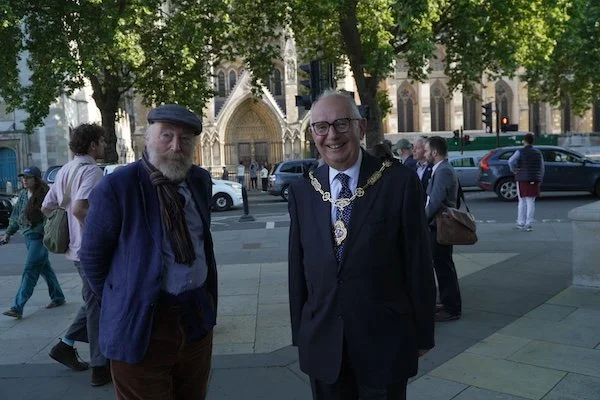Reflections on the second annual Parliamentary Walk
MPs, Peers and walking advocates gather in Parliament Square for the 2nd annual Parliamentary walk
On a sunlit Parliament Square this month, more than 50 people – including MPs, Peers, the Lord Mayor of Westminster, and leading figures from across the walking and active travel sectors – gathered for the second annual Parliamentary Walk.
Organised by the All Party Parliamentary Group for Cycling & Walking (APPGCW), with support from the University of Westminster and Footways CIC, the event set out to champion walking as a vital mode of transport and highlight both the challenges and opportunities presented by urban streets and spaces.
Parliament Square itself starkly illustrated the problem: effectively a high-traffic roundabout, it is one of the most polluted and pedestrian-hostile places in central London. Navigating it — particularly for anyone using a wheelchair — is extremely difficult. There are long-standing proposals to pedestrianise the east and south sides of the square, but a key question remains: when will they be realised?
Lord Mayor of Westminster, Paul Dimoldenberg with Footways co-founder, David Harrison, who led the tour
After a detour to find a route accessible for wheelchair users, the group continued to Queen Anne’s Gate, a quiet and elegant street flanked by 18th-century houses. Here, beside a statue of Queen Anne, we paused to reflect on what may have been London’s first Low Traffic Neighbourhood. Over 300 years ago, a wall was built across the street to prevent carriage cut-throughs – only to be demolished in 1873.
Crossing St James’s Park, the group encountered another accessibility barrier: the Duke of York steps, currently impassable for wheelchair users. While there is discussion of installing a lift, it remains a major obstacle. The route diverted along busy Pall Mall to Waterloo Place, where we heard encouraging updates about proposals to transform this grand space into a welcoming and inclusive public realm.
The walk concluded at the Crown Estate’s offices, where Clare Harrison from the Crown Estate and architects Allies and Morrison shared an ambitious vision for the transformation of Regent Street — a key artery in London’s walking network. Their plans aim to create a more welcoming, people-focused environment in one of the city’s most iconic public spaces.
Brian Deegan, Director of Inspections at Active Travel England was determined to be brief, but made it clear that walking must do the heavy lifting when it comes to making cities more active. Paul Dimoldenberg, the Lord Mayor of Westminster, used the occasion to declare himself the Walking Mayor, underlining Westminster’s commitment to walking as a core part of the city’s future. Andy MacNae MP closed the event with a vote of thanks on behalf of the APPG.
This year’s Parliamentary Walk was a powerful reminder that, though improvements are planned, many of our streets still reflect a time when the car was king. If we want healthier, fairer, and more liveable cities, we must reimagine and redesign our public spaces — putting walking at the centre of how we move and how we live.


